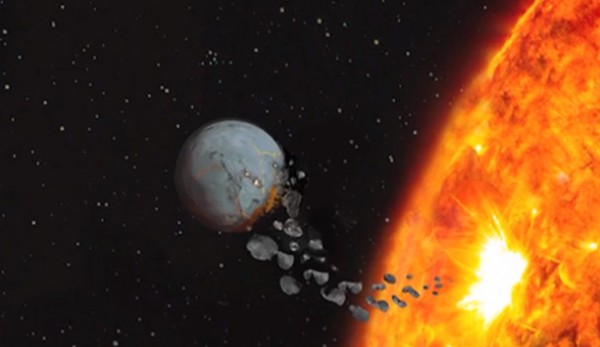Grad Student Discovers a Way to Detect Earth-eating Stars
| Robert Sarkanen | | May 22, 2014 09:16 AM EDT |
(Photo : Vanderbilt University)
A grad student of astronomy at Vanderbilt University developed a model to find stars that swallow planets. This may explain how planets are formed and help find other Earth-like planets outside of our solar system.
Student of Astronomy, Trey Mack, developed the model that shows what happens to a star when it swallows Earth-like planets during its development. Mack then applied this model to two twin stars to find out if they are so-called "Earth-eaters".
Like Us on Facebook
Professor of Astronomy Keivan Stassun, who supervised the study, went on to praise Mack, saying "Trey has shown that we can actually model the chemical signature of a star in detail, element by element, and determine how that signature is changed by the ingestion of Earth-like planets".
This research is believed to substantially add to scientists understanding of how planets are formed as well as the search for planets similar to Earth outside of our solar system.
Stars that swallow Earth-like planets are more likely to contain the same metals and elements of such planets with stars lacking these materials being more likely to still have planets like Earth.
As stars are formed from giant clouds of gas, they undergo a period of rapid expansion and contraction. As its dense gravitational field draws in nearby planetoids and rock materials, the nuclear reaction within the star increases. This leads to a period of rapid expansion, "swallowing" more materials, rocks and planets in its way that then become part of the star, until it reaches a stable size.
It was thought that though many stars may swallow some amounts of rocky materials, it is a more common occurrence during the latter stages of a star's life when the nuclear reaction grows unstable and the star expands before imploding. This new research shows many more planets may have been swallowed by still existing stars than previously believed.
Stars consists of more than 98% hydrogen and helium gasses, with the remaining 2% believed to be mostly metals. The exact amounts of which can be detected by observing the star's color, brightness and electromagnetic radiation, determining the star's density and temperature and in turn, the chemical reactions within.
Since developing the capacity to detect planets outside our solar system in the mid-90s, many astronomers have attempted to link the amount of metals in the stars to planet formation, with studies showing high metallicity correlates with the presence of planets.
Mack went on to look beyond simple iron content of stars and instead at the presence of 15 other specific elements relative to that of the Earth's sun, paying particular interest to aluminium, silicon and calcium, all of which have melting points higher than 600 degrees Celsius.
This because these materials are the building blocks for rocky planets like Earth and a high presence of the materials in a star suggests an "Earth-eater" star that has swallowed several such planets.
Mack, Stassun and co-author Simon Schuler then looked for the presence of these elements in the twin stars designated HD 20781 and HD 20782, stars not dissimilar to the Earth's sun. The pair also constitute the first twin star system where each star has its own planets.
As both stars presumably condensed out of the same gas cloud, both should have started with the same chemical compositions, only to change during their development. Their differences would therefore reveal what elements they individually consumed and how many smaller, Earth-like planets they each may have had and then consumed.
The astronomer's analysis of the stars revealed that their chemical composition includes an abundance of these materials compared to the Earth's sun and concluded that each of the twin stars most likely consumed an additional 10-20 rocky masses.
Professor Stassun went on to note the importance of the technique. "This work reveals that the question of whether and how stars form planets is actually the wrong thing to ask. The real question seems to be how many of the planets that a star makes avoid the fate of being eaten by their parent star?"
TagsEarth-eater, Sun, Star, Gas giant, Graduate student, Vanderbilt University, Twin stars, Chemical composition, Space, Universe, Exoplanets
©2015 Chinatopix All rights reserved. Do not reproduce without permission
EDITOR'S PICKS
-

Did the Trump administration just announce plans for a trade war with ‘hostile’ China and Russia?
-

US Senate passes Taiwan travel bill slammed by China
-

As Yan Sihong’s family grieves, here are other Chinese students who went missing abroad. Some have never been found
-

Beijing blasts Western critics who ‘smear China’ with the term sharp power
-

China Envoy Seeks to Defuse Tensions With U.S. as a Trade War Brews
-

Singapore's Deputy PM Provides Bitcoin Vote of Confidence Amid China's Blanket Bans
-

China warns investors over risks in overseas virtual currency trading
-

Chinese government most trustworthy: survey
-

Kashima Antlers On Course For Back-To-Back Titles
MOST POPULAR
LATEST NEWS
Zhou Yongkang: China's Former Security Chief Sentenced to Life in Prison

China's former Chief of the Ministry of Public Security, Zhou Yongkang, has been given a life sentence after he was found guilty of abusing his office, bribery and deliberately ... Full Article
TRENDING STORY

China Pork Prices Expected to Stabilize As The Supplies Recover

Elephone P9000 Smartphone is now on Sale on Amazon India

There's a Big Chance Cliffhangers Won't Still Be Resolved When Grey's Anatomy Season 13 Returns

Supreme Court Ruled on Samsung vs Apple Dispute for Patent Infringement

Microsoft Surface Pro 5 Rumors and Release Date: What is the Latest?










